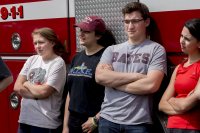
Graduate programs in law, health accept more than eight in 10 Bates College applicants
Eighty-six percent of Bates College seniors or alumni applying to graduate programs in the health professions were accepted for matriculation in fall 2003.
Meanwhile, 84 percent of Bates seniors or graduates who applied to programs in law were accepted, compared with a national average of 57 percent — this despite a 20 percent increase nationally from two years ago in the number of applicants to such programs, according to statistics from the Law School Admission Council.
Bates students are typically accepted into graduate programs in law and the health professions at a rate markedly higher than the national average. This speaks to both the quality of Bates students and the way Bates prepares students for life after graduation.
In the case of pre-health students, the college’s medical studies program helps students satisfy medical school requirements by, for instance, guiding students with their course selection and helping set up job-shadowing opportunities.
“We are always focused on the individual and her or his specific situation and goals,” says Lee Abrahamsen, associate professor of biology and biochemistry and the chair of the medical studies program. “Advice and strategies that are right for one student might be way off base for another. We don’t assume that one pre-med is like another.”
Of the Bates seniors or alumni who applied to 2003 post-graduate programs at allopathic or osteopathic medical school, 13 of 17 applicants were accepted, or 76 percent. For applicants to other health-care programs, such as dentistry, nursing and veterinary medicine, all 16 of the Bates students who applied were accepted last year.
Nationally, in 2003, 17,539 of 34,786 applicants to allopathic medical schools were accepted, or about 50 percent, according to information from the American Association of Medical Colleges.
Equivalent information for osteopathic schools wasn’t available, but for the 2001-02 academic year, according to the American Association of Colleges of Osteopathic Medicine, 3,043 of 6,898 applicants were enrolled in osteopathic schools, or about 44 percent. (Note that these applicants were actually enrolled, as opposed to accepted; not all accepted applicants will matriculate.)
“Applying to health professional programs requires strategy as well as brains,” Abrahamsen says. “A student unlikely to be accepted one year — because she or he hasn’t done much shadowing, for example — might do the shadowing and be a very competitive candidate the next year. There are many steps in presenting a strong application, and we can help students line them up.”
Bates in the mid-1990s instituted a pre-health advising system that kicks in during the first year. The medical studies committee and the Office of Career Services provide assistance across a wide spectrum, including personal advising, letters of recommendation and assistance with applications and interviews, and job-shadowing and internship opportunities.
The college even maintains an “internship network” of regional professionals — including not only physicians but dentists, veterinarians, nurse practitioners and nurse midwives, physical therapists and so on — with whom students can set up shadowing or internship experiences.
In law, Bates applicants also attained higher Law School Admission Test scores and grade-point averages than the national average. Moreover, Bates students and alumni were accepted to the top tier of law schools including Harvard, Michigan, Cornell, NYU and Duke.




